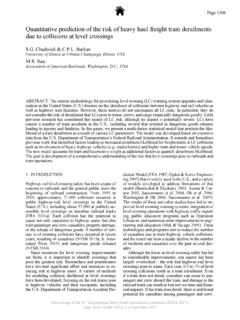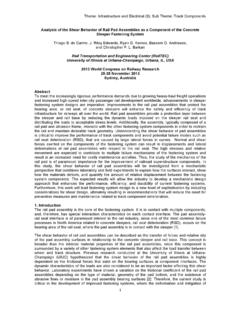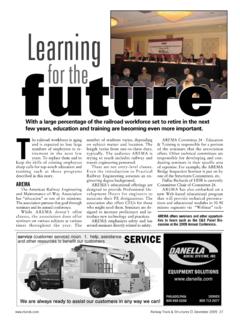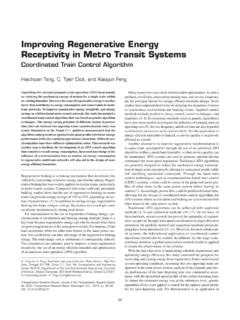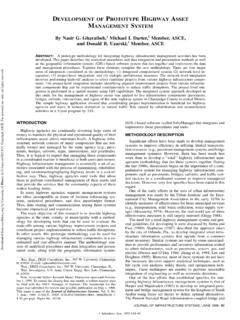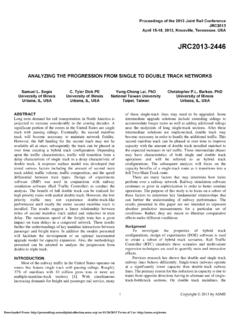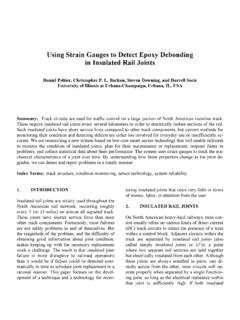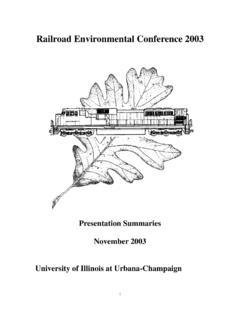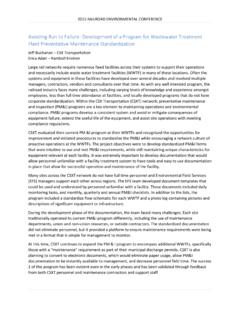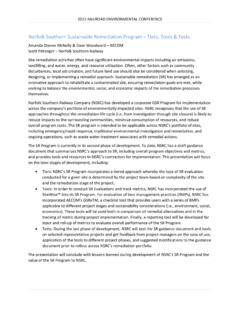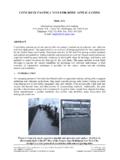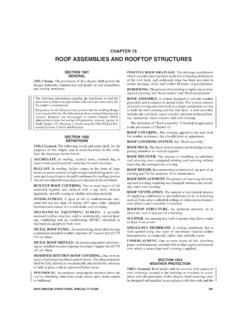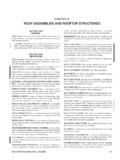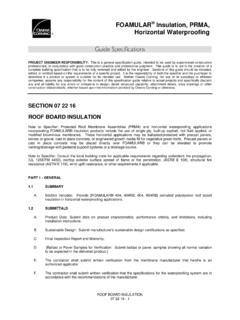Transcription of Framework for Short-Line Railroad Track Asset …
1 Framework for Short-Line Railroad Track Asset management andCondition ReportingMichael N. Grussing1, and Donald , , ,1. Research Civil Engineer, Engineer Research and Development Center, ConstructionEngineering Research Laboratory (ERDC-CERL), RO. Box 9005, Champaign, IL61826-9005, 217-398-5307; Uzarski Engineering, 2011 Barberry Circle, Champaign, IL 61821, military, short line and low-volume industrial Railroad networks require aunique infrastructure management approach that differs from commercial Class I andmost regional railroads due to their size and operational characteristics.
2 However, thisdoes not eliminate the need for condition assessment, maintenance and repair, and capitalplanning. An Engineered management System, RAILERR EMS, has been developed bythe Army Engineer Research and Development Center, Construction EngineeringResearch Laboratory (ERDC-CERL) as a decision support toolbox for managing theserail assets and reporting infrastructure condition and readiness. This approach includes1) categorizing the rail assets and attribute inventory information; 2) providing astandardized inspection process for identifying defects; 3) reporting operatingrestrictions; and 4) objectively quantifying Track condition.
3 The results of this process arethen used to develop recommended short- and long-term corrective repair and capitalrenewal strategies. This paper discusses the RAILER EMS process and Framework forreal-time objective condition and readiness reporting for military, short line, andindustrial rail infrastructure, citing an implementation case study at a military the recent rapid increase in rail transport volume and car weights andimpending maintenance and capacity issues, attention has been brought to railroadinfrastructure Asset management and capital planning.
4 While Class I and some regionalline haul railroads have developed their own business processes, military, short line, andother low-volume Railroad networks require a unique infrastructure managementapproach due to their size and operational characteristics. On these smaller networks,train speeds and traffic are usually lower, Track assets may be geographically fragmented,and the use of production-scale inspection equipment, such as automated Track geometryvehicles, is often cost prohibitive or impractical. As a result, the management practicesof these low-speed, low-volume networks often involve reactive maintenance and repair,correcting deficiencies that adversely affect near-term operations as they has shown that this practice has a long-term adverse impact on the track172 Infrastructure reporting and Asset management Downloaded from by University of Illinois At Urbana on 01/13/15.
5 Copyright ASCE. For personal use only; all rights reporting AND Asset management 173network, due to compounding deterioration from repeated wheel loads and deferredmaintenance and repairs on all but the most critical deficiencies. This highlights theimportance of and need for a standardized, robust, and meaningful condition assessmentmetric to support a more proactive repair and capital renewal planning example, the military owns and operates thousands of miles of trackwhich puts its scale on par with a small Class 1 or major regional Railroad .
6 However, thistrack is spread across installations worldwide, with each installation's network operatingrelatively independently akin to a short line or industrial network. This Track is ofstrategic importance to the movement of equipment, munitions, and supplies, andrequires a consistent inspection and condition assessment process to ensure that missionrequirements can be met for each local network in a cost efficient Railroad Track networks represent an important infrastructure Asset tosupport military transportation operations, they sometimes experience extended periodsof disuse until an event warrants mobilization of military assets.
7 Since trackinfrastructure competes for funding with other type of civil infrastructure at a militaryinstallation, Track may undergo long periods of little or no sustainment and capitalrenewal expenditures. This policy results in potential catastrophic network failures whenthe rail system experiences a surge in use. To maintain readiness, military Railroad trackundergoes periodic safety inspections to identify critical defects that could cause aderailment. The frequency of these safety inspections is weekly, monthly, or semi-annually based on the use of the Track (TM5-628, 1991).
8 Because these inspectionsaddress only critical and catastrophic issues, they do not provide the rigorous basis fordetermining and reporting a comprehensive Track condition measure or repair and capitalrenewal needs. To accomplish that, a more detailed Track inspection is required. Thisdetailed inspection is less frequent then a safety inspection and is sometimes performedin conjunction with planning rehabilitation work. To serve Asset management needs, thisdetailed inspection should result in consistent metrics to monitor condition EMS PROCESSThe RAILER methodology is a standardized best-practice management approachfor improved assessment and reporting of low-volume, low-speed ( , military, shortline, and industrial) rail infrastructure condition and readiness.
9 As a member of theEngineered management System (EMS) family of products that includes PAVER,ROOFER, AND BUILDER, it provides information and support to engineers, facilityplanners, and policy makers in managing rail infrastructure on a network basis (ERDC-CERL, 2006). This approach includes 1) categorizing the rail assets and organizingattribute information about the Track network; 2) providing a standardized detailedinspection process for identifying, classifying, and recording component defects anddeficiencies; 3) reporting operating restrictions imposed by governing Track standards dueto present defects; and 4) using the inspection defect information to objectively quantifytrack condition.
10 All of this information is then used in a systematic method to developrecommended short- and long-term corrective repair and capital renewal strategies. Infrastructure reporting and Asset management Downloaded from by University of Illinois At Urbana on 01/13/15. Copyright ASCE. For personal use only; all rights INFRASTRUCTURE reporting AND Asset MANAGEMENTB ased on the most recent Track inspection, the system reports condition, operatingrestrictions, and needed repairs using both tabular reporting and GIS AND INSPECTION IMPLEMENTATION PROCEDURESThe inventory process defines the Track assets to be assessed and managed.
